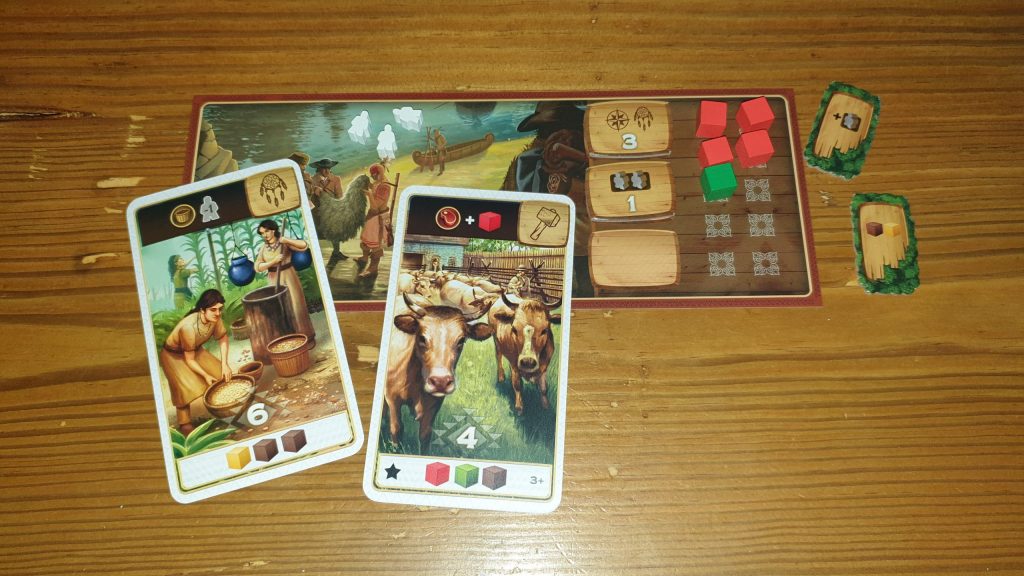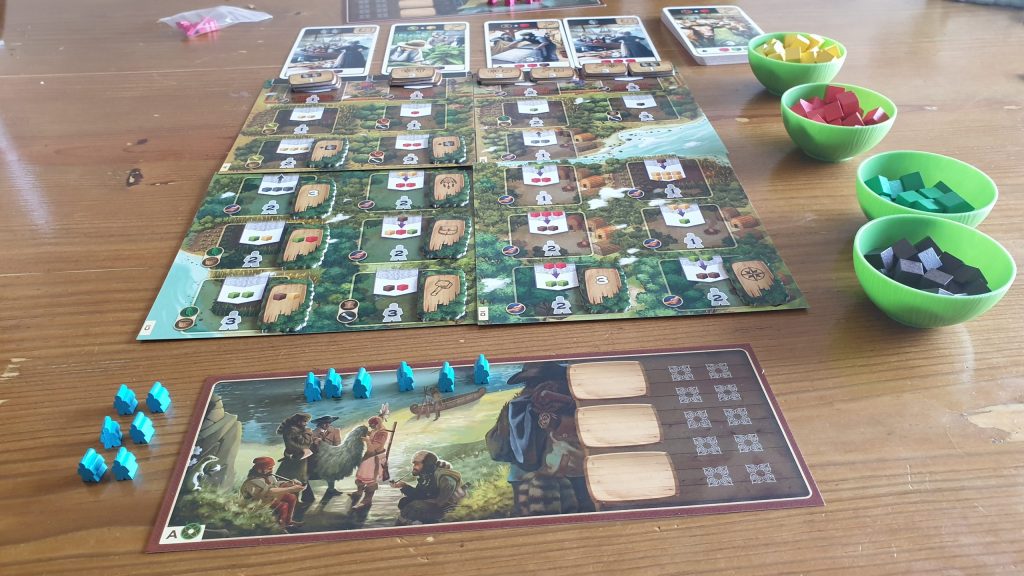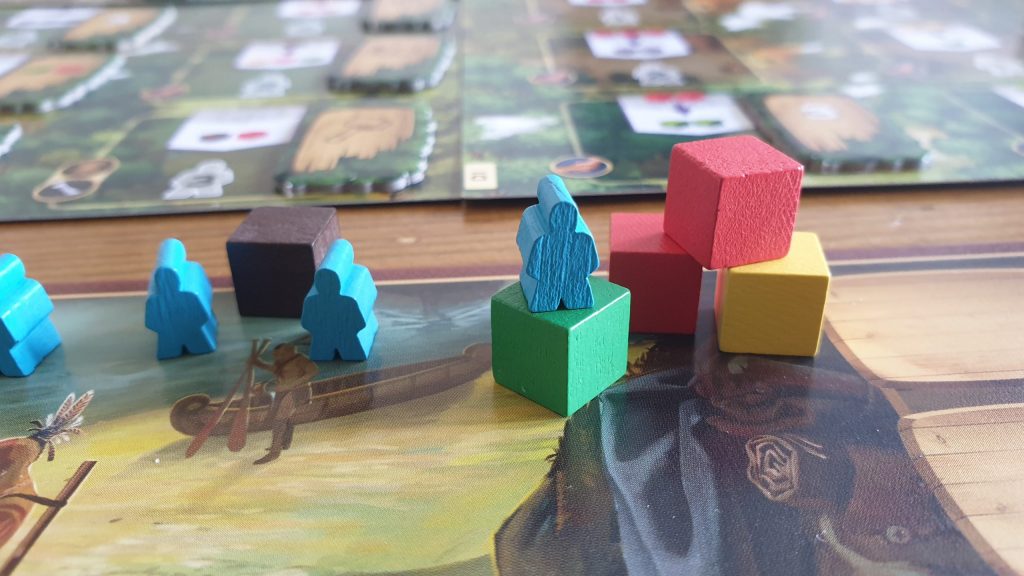Century A New World is the third installment of the Century trilogy of board games from designer Emerson Matsuuchi. Published by Plan B Games, the game is a standalone worker placement game, which can integrate with both Century Eastern Wonders and Century Spice Road. Century A New World sees 2 – 4 players spend around 45 minutes exploring new lands in the Americas. With corn, meat, tobacco and fur to be gained and traded, the bowls of cubes are back. However, does the game stand out on its own? Let’s find out!
Setting up players build the main board – by joining 4 location boards. Three of these (A-C) are always in play, with the final location board being a choice of 3 boards. The deck of point cards also needs to be created, with cards with a white star and denoted for higher player counts being set aside. The deck is placed face up, with the first 4 cards being dealt into fort spaces along the top of the main game board. A selection of bonus tiles are then placed onto these fort spaces and exploration tiles are placed to cover some of the worker placement spaces on the board. Finally, each player claims from the box a player board and 12 coloured workers – six of which they start with.
Played over a series of rounds, players will take it in turns performing one of two actions. Players can choose to work, activating a location with workers, or rest, to retrieve their workers. Each space has a requirement of workers that need to be sent there for the action to be performed, with the player placing meeples from their available pool onto the board accordingly. Actions allow players to gain resources, upgrade some resource cubes, trade one resource for another or spend resources at forts for point cards and bonuses.

Unlike most worker placement games, spaces are not blocked by worker meeples that have been placed on previous turns. Players can choose to oust opponent’s workers from a space, but never their own. By sending one additional meeple to the space the opponent’s meeples are returned to that player and the action is then performed as usual. While this means every action is within reach, players won’t want to do this too often if they can avoid it. After a few turns players will have run out of meeples, or at least have not enough to perform an action they want. Resting sees them reclaim their spent workers, clearing the spots for themselves and others alike.
When a player has collected a set of resource cubes which is denoted on a point scoring card the player can spend those resources to gain the card by visiting the fort locations. Simply returning the resource cubes to the bank the card is earnt. At this time if the player has 2 or fewer bonus tiles they could choose to also take a bonus tile attached to the fort location. The point scoring cards then shift left to fill the gap with a new one added into the right most empty fort space.
Upon purchasing a card the player receives an instant or on-going ability. These could see an exploration tile earnt – giving another bonus and opening up a new action location. Others make spaces on the main locations board cheaper, meeple-wise, to activate. Note that while these effects stack the value never reduces to lower than 1 meeple.

The game continues until one player has purchased their 8th point card, at which point the current round becomes the final one. Although one player causes the end of the game, it doesn’t mean they have won. Players combine points earnt from exploration tiles, point cards, bonus tiles and then gain 1 point per non-yellow resource cube they have. The winner is whomever has the most points, with ties split by reverse player order.
Someone with knowledge of either previous title in the Century series will see the similar core to the experience – the gaining and upgrading of cubes to purchase point cards. Players aren’t moving a boat around, nor are they building up a hand of action cards. The types of actions, the order of value of the coloured cubes and the way the names of the resources are forgettable remain the same though. How the experience is spiced up is not the shift to worker placement, it is the abilities from point cards. Giving the player the chance to combo together abilities to make spaces super cheap, or just have more workers available, means there are different routes to go down. The core aim is always to churn out cubes for point cards, though there certainly are many points up for grabs via bonuses.
The way that the game board is slightly reduced for a 2-3 player game is ideal as it uses the same exploration tiles that feature at all player counts. Simply covering additional spaces with exploration tiles means that they may still become accessible during play. This is a great way for each game to feel different as what gets explored changes. An interesting choice is also introduced, as players don’t want to open up an opportunity for their opponents. Getting the bonus to explore will be the last thing a player does on their turn. This means that the new space is available to the other players first!

One of my biggest gaming pet peeves is a heavy amount of admin to do during setup. Slowing down the process of getting the game to the table is the removal of tiles and cards. Some games will have this based on player count, which can be slightly frustrating. Century A New World takes this to another level with cards removed based on both player count and which Century games you are combining. This, by extension, means that there are a load of cards left in the box even when playing with the full player count.
The production quality of Century A New World is below average across the board – literally and figuratively. Plan B is often known for eye catching and top quality games, and the artwork that adorns the game is eye catching. Though this starts to go downhill when you notice the player boards feature identical artwork – which wasn’t the case with Century Spice Road. They are double sided though, for the other modes via combination. While the cubes aren’t as premium in look and feel as the gems of the Golem Edition of Spice Road, they do the job well. Then there are the fiddly micro sized meeples, which are equivalent in size to the cubes. For a worker placement game this seems a grand oversight, with players constantly interacting with these tiny wooden pieces.
The boards themselves are made of thin card at best, which are very easy to nudge and knock during play. This is an aspect when the game suffers as it aims to be not only one game but parts of others at the same time. The component issues don’t stop with the components, even the box insert doesn’t help. The section of the insert for the deck of cards isn’t deep enough. The cards are flush with the top of the insert, resulting in even a mild box movement seeing the cards overflow and shift in the box.
The core Century experience of gaining, upgrading and trading in sets of coloured cubes transitions well into the worker placement genre. This makes it all the more of a shame that the components let the game down. If the game instead came with one single (perhaps double sided) normal thickness main board, with meeples of decent size, you would have yourself a solid game, with interesting engine building and point scoring choices. While those choices are there the problems get in the way of the enjoyment of Century A New World. It offers more experiences than just this by integrating with the previous two titles, but it shouldn’t do this while making this title a lesser experience.
(Editor’s Note: Century A New World was provided to us by Asmodee for the review. The game is currently available from local board game stores, some of which are running dropoff services, find your local store here.)

